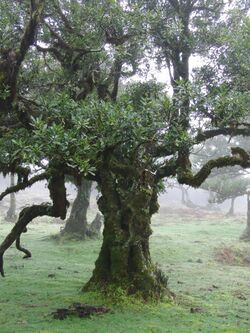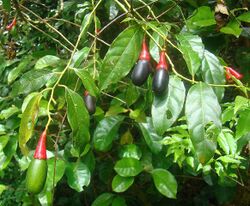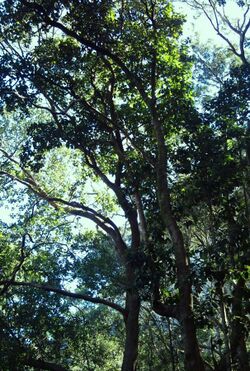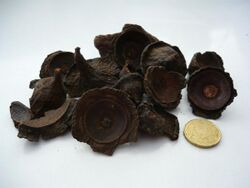Biology:Ocotea
| Ocotea | |
|---|---|

| |
| O. foetens on the highlands of Madeira Island | |
| Scientific classification | |
| Kingdom: | Plantae |
| Clade: | Tracheophytes |
| Clade: | Angiosperms |
| Clade: | Magnoliids |
| Order: | Laurales |
| Family: | Lauraceae |
| Genus: | Ocotea Aubl. |
| Species | |
|
Over 520, see List of Ocotea species | |
| Synonyms[1] | |
| |
Ocotea is a genus of flowering plants belonging to the family Lauraceae. Many are evergreen trees with lauroid leaves.
There are over 520 species currently accepted within the genus,[2] distributed mostly in tropical and subtropical areas of the Americas (around 300 species)[3] including the Caribbean and West Indies,[4][5] but also with some species in Africa, Madagascar [3] and the Mascarene Islands.[6] One species (O. foetens) is native to the Macaronesia (in Canary Islands and Madeira).[7] The genus is suspected to be paraphyletic.[8]
Description

They are trees or shrubs, occasionally with adventitious roots (O. hartshorniana, O. insularis). Leaves simple, alternate, rarely opposite or whorled.[9] The leaves are lauroid, they are commonly dark green glossy with sometimes brown on the underside and fragrant oil cells.[10]
The African and Madagascan species all have bisexual flowers (possessing both male and female parts), whereas many of the American species have flowers that are unisexual (either male or female).[3] The apetalous flowers are in small panicles.[citation needed]
The fruits are globose or oblong berries, 3–5 cm in length, hard and fleshy and at the junction of the peduncle part with the fruit covered by a cup-shaped, occasionally flat, cupule,[11] giving them an appearance similar to an acorn. The fruit is dark green, gradually darkening with maturity. The cupule at the base of the berry, can be more brightly colored. The fruit has a single seed wrapped in a hard coat and can be slightly lignified.[citation needed]
Names
The genus has no standard common name. Names often refer to the aroma of the wood, which can be strong and not always pleasant. Sweetwood is usually applied only to this genus,[12] although many names are also applied to this genus and other genera:
- Stinkwood can refer to several unrelated trees that have bad-smelling wood. Ocotea bullata is called black stinkwood or true stinkwood, and Ocotea foetens is also called stinkwood.
- Camphorwood is usually Cinnamomum camphora a close relative of Ocotea species.
- Rosewood (Peruvian rosewood, O. cernua) is normally Dalbergia or related members of the family Fabaceae.
The common names of some species refer to their similarity to other Lauraceae such as Sassafras (Brazilian sassafras: O. odorifera) or Laurus (Cape laurel: O. bullata, Sword laurel: O. floribunda, Guaika laurel: O. puberula, etc.).
Distribution and habitat

Most species of Ocotea are distributed across the tropical Americas, from Mexico to Northern Argentina including the West Indies. Species are also found in eastern Africa from South Africa to Ethiopia, in Gabon and Republic of the Congo in Central Africa, and on Madagascar and the Mascarene Islands. One species, Ocotea foetens, is native to the Canary Islands and Madeira in the North Atlantic.[13]
Ocotea species are distributed in subtropical and tropical regions, often at higher elevations. They are characteristic plants of many tropical and subtropical montane forests such as the Araucaria moist forests, Yungas, and Talamancan montane forests in the Americas, Afromontane forests including the Knysna-Amatole montane forests in Africa, and Laurisilva in the Macaronesian islands. In Madagascar and Brazil they also occur in lowland forests.[14]
Ecology
Most relatively small fruit species are of great environmental importance because they are the food of many endemic birds and mammals, especially in Islands, and premontane and montane forests.[9] The leaves of Ocotea species are the food source for the caterpillars of several species of endemic Lepidoptera, including several species of Memphis.[15] Some Memphis caterpillars feed solely on the leaves of one species of Ocotea; for example M. mora feeds only on O. cernua, and M. boisduvali feeds only on O. veraguensis[15]
Seed distribution of some Ocotea species is performed by frugivorous birds such as toucans, the three-wattled bellbird (family Cotingidae), quetzal[16] and Cape parrot.[17] Ocotea fruit is also consumed by several Columbiformes such as Columba trocaz,[18] Delegorgue's pigeon,[17] Bolle's pigeon (Columba bollii),[19] African wood pigeon,[20][21][22] and American doves.[23]
Most of the African tree species are ancient paleoendemic species,[24] which in ancient times were widely distributed on the continent.[19][24] This is not the case in the Americas: 89 species have been collected in Venezuela alone.[25]
Species of Ocotea can be attacked by various rot-inducing root pathogens, including Loweporus inflexibilis, Phellinus apiahynus[26] and Phytophthora cinnamomi.[27]
Some Ocotea species are used as nesting sites by ants, which may live in leaf pockets or in hollowed-out stems. The ants patrol their host plants more frequently in response to disturbance or to the appearance of insect pests such as grasshoppers.[28]
Uses

Ocotea produce essential oils, which are rich in camphor and safrole. East African camphorwood (O. usambarensis), Peruvian rosewood (O. cernua) and Brazilian sassafras (O. odorifera) are traded internationally.
Dried fruit cupules of ishpingo (O. quixos) are used in Ecuador to flavor beverages, such as colada morada.
Some fast growing Ocotea tree species are harvested commercially for timber. These include O. puberula, O. bullata (black or true stinkwood) and O. usambarensis. The timber is valued for its resistance to fungal decay.
O. odorifera (Brazilian sassafras) and O. kuhlmanni are frequently used as honey plants.
Selected species
The following are some of the species of Ocotea.[29] Distinguishing Ocotea species from Nectandra and other close relatives is problematic. Povedadaphne may be better placed in Ocotea.[citation needed]
- Ocotea aciphylla
- Ocotea acutifolia (Nees) Mez
- Ocotea albida
- Ocotea albopunctulata
- Ocotea amazonica
- Ocotea amplifolia
- Ocotea arnottiana
- Ocotea atirrensis
- Ocotea bangii
- Ocotea basicordatifolia
- Ocotea benthamiana
- Ocotea bofo
- Ocotea bullata – black stinkwood, true stinkwood
- Ocotea camphoromoea
- Ocotea catharinensis
- Ocotea cernua – Peruvian rosewood
- Ocotea clarkei
- Ocotea corymbosa Mez
- Ocotea cuneifolia
- Ocotea cymbarum (often included in O. odorifera)
- Ocotea diospyrifolia (Meisn.) Mez
- Ocotea dispersa (Nees) Mez
- Ocotea divaricata (Nees) Mez
- Ocotea domatiata Mez
- Ocotea fasciculata (Nees) Mez
- Ocotea floribunda
- Ocotea foeniculacea – black sweetwood
- Ocotea foetens – "til", "tilo"
- Ocotea gabonensis
- Ocotea glaucosericea
- Ocotea glaziovii Mez
- Ocotea gracilis
- Ocotea guianensis
- Ocotea harrisii
- Ocotea heterochroma
- Ocotea indecora (Schott) Mez
- Ocotea insularis
- Ocotea illustris
- Ocotea infrafoveolata
- Ocotea jelskii
- Ocotea jorge-escobarii
- Ocotea kenyensis
- Ocotea lancifolia
- Ocotea lancilimba
- Ocotea langsdorffii
- Ocotea leucoxylon – loblolly sweetwood
- Ocotea mandonii
- Ocotea marmellensis
- Ocotea matogrossensis
- Ocotea megaphylla
- Ocotea minarum Mart. ex Nees
- Ocotea monzonensis
- Ocotea moschata – nemoca
- Ocotea nemodaphne – laurel sassafras
- Ocotea notata (Nees) Mez
- Ocotea oblonga
- Ocotea obtusata
- Ocotea odorifera – Brazilian sassafras
- Ocotea oocarpa
- Ocotea otuzcensis
- Ocotea pachypoda
- Ocotea pauciflora
- Ocotea porosa
- Ocotea porphyria
- Ocotea portoricensis
- Ocotea prunifolia
- Ocotea puberula
- Ocotea pulchra Vattimo-Gil
- Ocotea quixos – ishpingo
- Ocotea raimondii
- Ocotea rivularis
- Ocotea robertsoniae
- Ocotea rotundata
- Ocotea rubrinervis
- Ocotea rugosa
- Ocotea sericea
- Ocotea silvestris Vattimo-Gil
- Ocotea smithiana
- Ocotea spathulata
- Ocotea spectabilis
- Ocotea spixiana (Nees) Mez
- Ocotea staminoides
- Ocotea tabacifolia (Meisn.) Rohwer
- Ocotea teleiandra (Meisn.) Mez
- Ocotea urbaniana Mez
- Ocotea uxpanapana
- Ocotea vaccinioides Meisn.
- Ocotea velloziana
- Ocotea velutina Mart.
- Ocotea viridiflora
- Ocotea wrightii – Wright's laurel canelon
Formerly placed here
- Chlorocardium rodiei (bibiru, "greenheart"), as O. rodiei
- Nectandra coriacea ("lancewood"), as O. catesbyana, O. coriacea
- Sextonia rubra, as O. rubra[2]
- Kuloa usambarensis – (East African camphorwood) as O. usambarensis
Fossil record
†Ocotea hradekensis from the early Miocene, has been described from fragmentary fossil leaf compressions that have been found in the Kristina Mine at Hrádek nad Nisou in North Bohemia, the Czech Republic. O. foetens from the Canary Islands is its nearest living relative.[30] Fossil †Ocotea heerii leaf impressions of Messinian age (ca. 5.7 Ma) have been uncovered in Monte Tondo, northern Apennines, Italy.[31]
References
- ↑ "Tropicos.org". http://www.tropicos.org/Name/40030080?tab=synonyms.
- ↑ "Ocotea Aubl.". Board of Trustees of the Royal Botanic Gardens, Kew. 2021. https://powo.science.kew.org/taxon/urn:lsid:ipni.org:names:325868-2.
- ↑ 3.0 3.1 3.2 Henk van der Werff (1996). "Ocotea ikonyokpe, a new species of Lauraceae from Cameroon". Novon 6 (4): 460–462. doi:10.2307/3392056.
- ↑ "ITIS, Integrated Taxonomic Information System". https://www.itis.gov/servlet/SingleRpt/SingleRpt?search_topic=TSN&search_value=834865.
- ↑ Alain H. Liogier; Luis F. Martorell (2000). Flora of Puerto Rico and Adjacent Islands: a Systematic Synopsis. ISBN 9780847703692. https://books.google.com/books?id=ISlUCW8p5GcC&pg=PA62.
- ↑ Kostermans, Achmad Jahja (GH); Marais, W. (1979). Ocotea (Lauraceae) in the Mascarene Islands. H.M. Stationery Office. https://books.google.com/books?id=KHjvMAAACAAJ. Retrieved May 19, 2012.
- ↑ da Silva Menezes de Sequeira, M.P.; Beech, E. (2017). "Ocotea foetens". IUCN Red List of Threatened Species 2017: e.T30328A81868200. doi:10.2305/IUCN.UK.2017-3.RLTS.T30328A81868200.en. https://www.iucnredlist.org/species/30328/81868200. Retrieved 11 November 2021.
- ↑ Penagos Zuluaga, Juan C.; Werff, Henk; Park, Brian; Eaton, Deren A. R.; Comita, Liza S.; Queenborough, Simon A.; Donoghue, Michael J. (2021). "Resolved phylogenetic relationships in the Ocotea complex (Supraocotea) facilitate phylogenetic classification and studies of character evolution". American Journal of Botany 108 (4): 664–679. doi:10.1002/ajb2.1632. PMID 33818757.
- ↑ 9.0 9.1 José González (2007). "Flora Digital De Palo Verde". http://www.ots.ac.cr/florulapv/documents/Lauraceae.pdf?V_COLLECTIONSOrder=Sorter_HABITAT&V_COLLECTIONSDir=DESC.
- ↑ Andrés Castillo Q. (2010). "Manual dendrológico de las principales especies de interés comercial actual y potencial de la zona del Alto Huallaga" (in es). Cámara Nacional Forestal. http://es.scribd.com/doc/80809763/Manual-Dendrologico.
- ↑ Henk van der Werff (2002). "A synopsis of Ocotea (Lauraceae) in Central America and Southern Mexico". Annals of the Missouri Botanical Garden 89 (3): 429–451. doi:10.2307/3298602. https://www.biodiversitylibrary.org/part/16387.
- ↑ "Plants Profile: Ocotea Aubl.". USDA. http://plants.usda.gov/java/profile?symbol=OCOTE.
- ↑ "Ocotea Aubl." Plants of the World Online, Kew Science. Accessed 28 April 2022. [1]
- ↑ Rohwer, Jens (1986). "Prodromus einer Monographie der Gattung Ocotea Aubl. (Lauraceae), sensu lato". https://www.researchgate.net/publication/265914777.
- ↑ 15.0 15.1 Daniel H. Janzen. "About Memphis mora". Ontario Genomics Institute. http://www.ontariogenomics.ca/outreach/BOLD10.
- ↑ J. Phil Gibson; Nathaniel T. Wheelwright (1995). "Genetic structure in a population of a tropical tree Ocotea tenera (Lauraceae): influence of avian seed dispersal". Oecologia 103 (1): 49–54. doi:10.1007/BF00328424. PMID 28306944. http://www.bowdoin.edu/faculty/n/nwheelwr/dissemination/GeneticStructure.pdf. Retrieved May 18, 2012.
- ↑ 17.0 17.1 "Ocotea bullata". PlantZAfrica.com. November 22, 2002. http://www.plantzafrica.com/plantnop/ocoteabull.htm.
- ↑ Paulo Oliveira; Patricia Marrero; Manuel Nogales (2002). "Diet of the endemic Madeira laurel pigeon and fruit resource availability: a study using microhistological analyses". The Condor 104 (4): 811–822. doi:10.1650/0010-5422(2002)104[0811:doteml2.0.co;2].
- ↑ 19.0 19.1 "MANAGEMENT of Natura 2000 habitats * Macaronesian laurel forests (Laurus, Ocotea) 9360: Directive 92/43/EEC on the conservation of natural habitats and of wild fauna and flora". http://ec.europa.eu/environment/nature/natura2000/management/habitats/pdf/9360_Macaronesian_laurel_forests.pdf.
- ↑ David Gibbs (2010). Pigeons and Doves: a Guide to the Pigeons and Doves of the World. A&C Black. ISBN 9781408135563. https://books.google.com/books?id=r__Tx8QKQfMC&pg=PA191. Retrieved May 20, 2012.
- ↑ "Biodiversity Explorer: The web of life in southern Africa". Biodiversityexplorer.org. http://www.biodiversityexplorer.org/birds/columbidae/columba_arquatrix.htm.
- ↑ "Assessment Of Forest User Groups And Their Relationship To The Condition Of The Natural Forests In The Uluguru Mountains". Wildlife Conservation Society of Tanzania (WCST). n.d.. http://easternarc.or.tz/downloads/Uluguru/WCST-UMBCP-reports/Forest%20users%20in%20the%20ulugurus.pdf.
- ↑ Mahabir P. Gupta (2006). "Medicinal Plants Originating In The Andean High Plateau And Central Valleys Region Of Bolivia, Ecuador And Peru". http://www.unido.org/fileadmin/import/58569_medicinal_final.pdf.
- ↑ 24.0 24.1 Ben H. Warren; Julie A. Hawkins (2006). "The distribution of species diversity across a flora's component lineages: dating the Cape's 'relicts'". Proceedings of the Royal Society B: Biological Sciences 273 (1598): 2149–2158. doi:10.1098/rspb.2006.3560. PMID 16901834.
- ↑ Hernán E. Ferrer-Pereira (2009). "Lauraceae at the Herbario Nacional de Venezuela (VEN)". Herbario Nacional de Venezuela. http://www.scielo.org.ve/pdf/abv/v32n1/art10.pdf.
- ↑ P. Renvall; T. Niemelä (1993). "Ocotea usambarensis and its fungal decayers in natural stands". Bulletin du Jardin Botanique National de Belgique 62 (1/4): 403–414. doi:10.2307/3668286.
- ↑ W. A. Lübbe; G. P. Mostert (1991). "Rate of Ocotea bullata decline in association with Phytophtora cinnamomi at three study sites in the Southern Cape indigenous forests". South African Forestry Journal 159 (1): 17–24. doi:10.1080/00382167.1991.9630390.
- ↑ Jean Stout (1979). "An association of an ant, a mealy bug, and an understory tree from a Costa Rican rain forest". Biotropica 11 (4): 309–311. doi:10.2307/2387924.
- ↑ {{citation | mode = cs1 | title = Ocotea Aubl. | work = Germplasm Resources Information Network (GRIN) | url = https://npgsweb.ars-grin.gov/gringlobal/taxonomydetail.aspx?8359 | publisher = [[Organization:Agricultural Research ServAgricultural Research Service (ARS), United States Department of Agriculture (USDA) | access-date = February 19, 2010 }}
- ↑ A review of the early Miocene Mastixioid flora of the Kristina Mine at Hrádek nad Nisou in North Bohemia, The Czech Republic, January 2012 by F. Holý, Z. Kvaček and Vasilis Teodoridis - ACTA MUSEI NATIONALIS PRAGAE Series B – Historia Naturalis • vol. 68 • 2012 • no. 3–4 • pp. 53–118
- ↑ Palaeoenvironmental analysis of the Messinian macrofossil floras of Tossignano and Monte Tondo (Vena del Gesso Basin, Romagna Apennines, northern Italy) - Vasilis Teodoridis, Zlatko Kvacek, Marco Sami and Edoardo Martinetto - December 2015 DOI: 10.14446/AMNP.2015.249.
External links
Wikidata ☰ Q3305677 entry
 |

